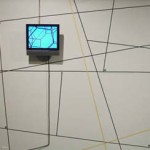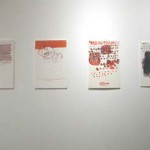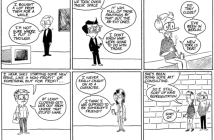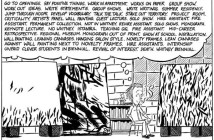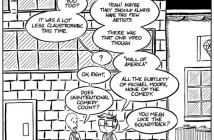Nayda Collazo-Llorens’ Mindscapes is a conceptually coherent and thoughtfully installed exhibition. However, despite the quality of its assembly, it is of limited impact as a whole. Its efforts to create a Gestamkunstwerk work best as a well-conceived framework for separate pieces of variable interest, a number of which only serve the larger structure.
The show begins strong, particularly with the wall drawing, composed of drafting and masking tapes, as well as transfer and vinyl lettering. It looks somewhere between a city map and an Al Held painting, and its increasing density as one moves through the space of the gallery creates an interesting tension. One wants to stop and look, to linger over single parts, and yet its insistent linearity, coupled with that of the floor plan, urges you to continue moving forward. These contradictory responses are heightened by the placement of a flat screen monitor in front of a less densely worked area, in which one sees yet another instance of linear structures in tension, turning back on themselves, in the form of a looped video. In this video, a mobile camera visually traverses a children’s climbing structure made of red rope and S-clips. While the formal relationship between the drawing and the video is apparent and well considered, the video is less interesting for what it does than for what it depicts – the prospect of the actual climbing structure threatens to overshadow even the drawing in front of which its image appears. The video itself, while briefly diverting, functions best as a prelude to the development of the wall drawing.
In addition to the tapelines and arrows, the wall drawing is composed of phrases and numbers of varying types. They include first person statements, quotations from sets of instructions, weather notations, third person narrations, quotes from fortune cookies, and seemingly random sets of numbers. There is a quality of forced urgency to many of the texts, which employ a clipped, “just the facts” diction, whether in the first person speech or the instructional/imperative statements with which they are often coupled. A vague story of a journey is being told, in this case aboard a plane, which may well be experiencing difficulties. Nonetheless, it is told in such intermittent rushes of overwrought prose like “A twisting sensation about to implode can’t think clear don’t know how to get out” that the language, rather than pulling us into the narrative, pushes us back out to the surfaces of the drawing, which are far more elegant and economical. Whereas the prose insists on its seriousness and significance, only to undermine itself with the tone of its insistence, the drawing embodies those qualities, and so draws us further into the installation.
The wall drawing also mentions different types of vision – panoramic perception, stereoscopic vision, and spherical vision. While some of these have obvious conceptual counterparts in the installation, others are simply phrases we encounter again as we pass through the installation, and their particular relevance to this narrative is unclear. Similarly, while many more sets of numbers appear in the installation, in nearly every one of the small drawings, as well as on many of the sticks in the installation, they fail to evoke anything in particular. Is there a system so complicated I am unable to parse it? Or are these numbers and phrases meant to evoke, as the essay by Deborah Cullen states, “the barrage of information to which we are subjected daily”? Regardless, they operate too plainly as a signifier (despite the vagueness of their signification) to be of sustained interest.
From the wall drawing one moves to the first group of small drawings. Keeping in mind the intention of a total work, the unevenness of these drawings is understandable. While there are some standouts, particularly one in which an aggregation of arrows forms something like a wave over a ground of a disrupted grid, many of the drawings devolve upon closer attention into somewhat clichéd instances of “obsessive mark-making”, playing with tired binaries of order and chaos. This is most apparent in those drawings, some of which are best at long distances, which devolve upon closer attention into seemingly generic oval forms ranged into loose grid formations. Grids are disrupted, notations are made, and attractive but vague and unpersuasive drawings are created.
The second set of drawings is similarly uneven. There are some compelling uses of line, and they use color in an interesting, if overly tasteful way. There are particularly interesting works in which a solid color oval is ringed by other colors. It is a small situation, but the tension of the relationships in the drawing (are the rings other ovals, or just rings?) as well as the tension between the image and the paper that frames it, make for a compelling drawing. Unfortunately, the lighting of the show, while it effectively subsumes the drawings into the show as a work, makes it difficult to study them more closely. The effect is reminiscent of a restaurant where it’s too dark to see the food. However, this may well be appropriate, as a number of the drawings are best as simple instances of color in an otherwise dark room. While the entrance of a lemon yellow oval onto a sheet of paper is a dramatic moment in the context of a darkened room, it is drained of its power as one comes closer, and simply appears to be a precious gesture. Many of these drawings reiterate formal strategies of geometric/color field painting (Leon Polk Smith comes to mind), but lose their power in the process of being scaled down to sketchbook size.
Whereas the drawings of the first, brightly lit section have their counterpart in the map-like wall drawing, the drawings of the second section have their counterpoint in an irregular ring of sticks and branches, each one separately hung from the ceiling at around eye level, such that one must duck in order to enter the space they demarcate. Each one of these sticks has been dipped in or painted with gesso or white paint on its lower end, which has then been treated in a number of ways. Some have been wrapped in wire, others have been marked with numbers (handwritten or seemingly rubber-stamped), and others still have had the paint cut or scratched off in areas. The use of numbers here, in context with the creation of space within the ring of sticks, calls up ritual associations, as if we have come across the remnants of a ceremony. The ring of sticks is mirrored by a 9 x 6 inch drawing of vertical lines, a pristine, black on white sketch of the installation. This drawing is hung separately from all of the other drawings, in an area defined by the pillars of the gallery. In the extraordinary amount of space given to this not intrinsically noteworthy drawing – all of the drawings are of the same size, and many are far more interesting as drawings than this work – Collazo-Llorens appears to be indicating to us the importance of this particular instantiation of the roughly oval form which appears in the large majority of her drawings.
The two-channel video projection is the centerpiece of the show. In it, the themes of the rest of the show are condensed and focused through a briefly linear narrative of confinement and escape, beginning aboard a crowded train and taking us outdoors, among grass, swimming pools, and eventually looking down on a seaside city. These experiences are mediated by language, or rather languages, as the narrative is occasionally interrupted with texts and statements appearing on the screen, both Spanish and English, sometimes advancing the skeleton of a narrative, other times simply coming and going, to no discernible effect – more instances of the “barrage of information” manifested by the phrases occurring in the wall drawing, as well as the groups of numbers which provide continuity between the drawings and the hanging stick installation. The movement between languages is paralleled by the movement between types of language, from personal narrative to instructional imperatives to weather reports, just as the imagery with which it is paired slips between interior and exterior views, focusing on images which are emblematic of “nature”, although plainly constructed spaces, such as a well kept lawn and the intensely blue water of a swimming pool. Overall the relationship between language and image is most successful in the two-channel video, as the images work well with the sometimes effortful, sometimes actual, matter-of-factness of the statements that scroll across them.
Most compelling in this video is the sequence which begins with the phrase “enter password”, and which continues to exhort the viewer, imagined as interacting with the video, to run, to increase speed, to jump (when looking over a seaside city from a tall building) and to flap one’s (previously unmentioned) wings. In this instance, the use of the imperative voice is quite successful. We as viewers respond to these commands simply in the act of watching the video, and in the journey it takes us on, are rewarded for our complicity.
- Nayda Collazo-Llorens, Mindscapes 2006.
- Nayda Collazo-Llorens, Mindscapes 2006.
- Nayda Collazo-Llorens, Mindscapes 2006.
Links:
Space Other
"Mindscapes" is on view January 14th through February 25, 2006 at Space Other.
All images are courtesy of the artist and Space Other.


